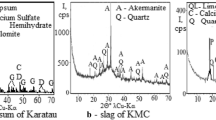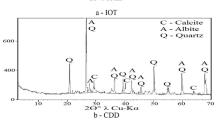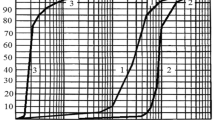Abstract
The main purpose of this work was to look for new application for hazardous sewage sludge, wood ash, and lime production waste for replacement of traditional natural construction raw materials with high environmental efficiency. The composites reached the 13.0 MPa of axial resistance strength value on the 28th day with 16.07% of the water absorption values, 1.0% of expansion coefficient, and 1.675 g/cm3 of bulk density. The chemical, mineralogical, and granulometric compositions of the raw and developed materials studied by the complementary XRD, XRF, SEM, EDS, and LAMMA methods demonstrate a new mainly amorphous carbonate synthesis, responsible for the new structures formation with mechanical properties that exceed the requirements of the Brazilian technical standards. The results of the leaching and solubility tests showed their compliance with the Brazilian sanitary standards.





Similar content being viewed by others
References
Hawking SW (2018) http://www.independent.co.uk/news/science/stephen-hawking-pollution-stupidity-artifical-intelligence-warfare-biggest-threats-mankind-a7106916.html. Accessed 28 June 2016
Richter CA (2004) Treatment of sediments from wastewater treatment plant. Edgard Blücher Ltda, São Paulo
Ščančar J, Milačič R, Stražar M, Burica O (2000) Total metal concentrations and partitioning of Cd, Cr, Cu, Fe, Ni and Zn in sewage sludge. J SciTotal Environ B 250, 1:–3, 9–19. https://doi.org/10.1016/S0048-9697(99)00478-7
Mymrin V. Industrial and municipal wastes utilization as economical and environment efficient raw materials. http://paginapessoal.utfpr.edu.br/mymrinev. Accessed 18 Mar 2012
Wang X, Zheng G, Chen T, Shi X, Wang Y, Nie E, Liu J (2019) Effect of phosphate amendments on improving the fertilizer efficiency and reducing the mobility of heavy metals during sewage sludge composting. J Environ Manag 235:124–132. https://doi.org/10.1016/j.jenvman.2019.01.048
Fang W, Zhang P, Zhang T, Requeson DC, Pose M (in press)(2019) Upgrading volatile fatty acids production through anaerobic co-fermentation of mushroom residue and sewage sludge: performance evaluation and kinetic analysis. J Environ Manag 241:612–618. https://doi.org/10.1016/j.jenvman.2019.02.052
Zdybel J, Karamon J, Kłapeć T, Włodarczyk-Ramus M, Różycki M, Bilska-Zając E, Kominek A, Cencek T (2019) Negative effect of flocculant (cationic acrylamide) on detectability of the nematode eggs in sewage sludge. J Environ Manag 231:905–908. https://doi.org/10.1016/j.jenvman.2018.10.105
Fijalkowski K et al (2017) The presence of contaminations in sewage sludge—the current situation. J Environ Manage 203(3):1126–1136. https://doi.org/10.1016/j.jenvman.2017.05.068
Grobelak A, Grosser A, Kacprzak M, Kamizela T (2019) Sewage sludge processing and management in small and medium-sized municipal wastewater treatment plant-new technical solution. J Environ Manag 234:90–96. https://doi.org/10.1016/j.jenvman.2018.12.111
Peng L et al (2018) Combining microwave irradiation with sodium citrate addition improves the pre-treatment on anaerobic digestion of excess sewage sludge. J Environ Manag 213:271–278. https://doi.org/10.1016/j.jenvman.2018.02.053
Paolini V, Petracchini F, Carnevale M, Gallucci F, Perilli M, Esposito G, Segreto M, Occulti LG, Scaglione D, Ianniello A, Frattoni M (2018) Characterisation and cleaning of biogas from sewage sludge for biomethane production. J Environ Manag 217:288–296. https://doi.org/10.1016/j.jenvman.2018.03.113
Herzel H, Krüger O, Hermann L, Adam C (2016) Sewage sludge ash—a promising secondary phosphorus source for fertilizer production. J Sci Total Environ B 542:1136–1143. https://doi.org/10.1016/j.scitotenv.2015.08.059
Hukari S, Hermann L, Nättorp A (2016) From wastewater to fertilisers—technical overview and critical review of European legislation governing phosphorus recycling. J SciTotal Environ B 54:1127–1135. https://doi.org/10.1016/j.scitotenv.2015.09.064
Becker GC, Wüst D, Köhler H, Lautenbach A, Kruse A (2019) Novel approach of phosphate-reclamation as struvite from sewage sludge by utilizing hydrothermal carbonization. J Environ Manag 238:119–125. https://doi.org/10.1016/j.jenvman.2019.02.121
Naik TR et al (2001) Wood ash: a new source of pozzolanic material. Report No. CBU-2001-10 REP-435. University of Wisconsin, Milwaukee
Oburger E, Jäger A, Pasch A, Dellantonio A, Stampfer K, Wenzel WW (2016) Environmental impact assessment of wood ash utilization in forest road construction and maintenance—a field study. J SciTotal Environ 544:711–721. https://doi.org/10.1016/j.scitotenv.2015.11.123
Sakthivel SR et al (2012) Wood ash as a magnesium source for phosphorus recovery from source-separated urine. J Sci Total Environ 419:68–75. https://doi.org/10.1016/j.scitotenv.2011.12.065
Mymrin V et al (2017) Utilization of sediments dredged from marine ports as a principal component of composite material. J Clean Prod 142:4041–4049. https://doi.org/10.1016/j.jclepro.2016.10.035
Anastas PT, Warner JC (1998) Oxford University Press: New York. http://www.acs.org/content/acs/en/greenchemistry/what-is-green-chemistry/principles/12-principles-of-green-chemistry.html
NBR 15270-3 (2005) Flexural rupture strength measurement and water adsorption measurements of ceramic bricks, Rio de Janeiro. http://www.portoblocos.com.br/
Twort A et al (2005) Water Supply, 5th edn, IWA Publishing ISBN O 340 72018 2
NBR 10004 (2004) Solid wastes: classification, Rio de Janeiro
NBR 6453 (2003) Lime virgin for construction, Rio de Janeiro
Mymrin V (1987) Theoretical bases of clay soils strengthening by ferrous slags for road base construction. D.Sc. thesis, Lomonosov State University (MGU), Moscow
Author information
Authors and Affiliations
Corresponding author
Additional information
Publisher’s note
Springer Nature remains neutral with regard to jurisdictional claims in published maps and institutional affiliations.
Rights and permissions
About this article
Cite this article
Mymrin, V., de Andrade, C., Alekseev, K. et al. Structure formation processes of sustainable construction material from hazardous sewage sludge with additions of wood ash, and lime production waste. Int J Adv Manuf Technol 105, 5191–5201 (2019). https://doi.org/10.1007/s00170-019-04408-4
Received:
Accepted:
Published:
Issue Date:
DOI: https://doi.org/10.1007/s00170-019-04408-4




